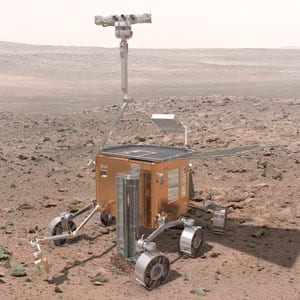Astrobiology – the hunt for alien life
By news editor, on 15 September 2011
Dr Lewis Dartnell (UCL Space & Climate Physics) is, in his own words, “paid to hunt for aliens”. Lucy Harper from the Society for Applied Microbiology went to his fascinating talk at the British Science Festival entitled, ‘Astrobiology – the hunt for alien life’.
We humans, and the billions of species we share the planet with, are protected from harmful radiation by the Earth’s magnetic field and a thick atmosphere.
But on other planets, such as Mars, radiation levels are much higher and these “Martian death rays” are damaging to life as we know it.
Dr Dartnell is trying to find out how long organisms can survive when exposed to this level of radiation.
To do this, he is growing extremophiles that he’s taken from Dry Valleys in Antarctica – the driest place on Earth and, therefore, the most similar to Mars – and “smacking them with high doses of gamma rays”. From this, he will be able to calculate how far down into the surface of Mars you would need to drill to find “life”.
So what is astrobiology? After showing us the NASA definition, Dr Dartnell explained that this question inevitably leads to the bigger question: “What is life?” To us, it’s elephants, squid, trees, toadstools and microbes, but elsewhere in the universe life is reduced to a mere shadow biosphere.
He went on to talk about the extremophiles that he’s studying, from thermophiles to psychrophiles and the methane worm that survives by “eating frozen fart gas”. They all enjoy environments that would kill a human, but the most amazing thing about them is that if you plot the range of conditions under which they can survive – so the temperature plotted against salinity and acidity/alkalinity – you end up with a survival cloud in the shape of a boot.
This overlaps with conditions on other planets, proving that it’s not completely crazy to be looking for “life” on other planets.
Dr Dartnell discussed the planets that he and his team are hoping to explore. Mars will be explored by ExoMars, a probe that will be launched in 2018 and will drill into the surface. Jupiter’s moon Europa is thought to be the most water-filled (and therefore similar to Earth) place in our solar system and he would LOVE to look for hydrothermal vents there.
Looking further afield, he described how, in the past 15 years, numerous alien solar systems have been discovered and said, “We are beginning to find Earth-like planets in other solar systems.”
This is a fast-moving field – so much so that a new planet has been discovered in the past couple of days. It’s called HD85512b – “That’s what happens when astrophysicists are asked to name things,” he quipped. This is a “super-Earth” – a planet about three times larger than Earth, but which rotates around its sun. This means it’s at the right temperature to support the existence of oceans and lakes on its surface.
Dr Dartnell explained that, last year, they launched a space telescope called Kepler that will spend three years monitoring more than 100,000 stars located along the spiral arm of our galaxy (the Milky Way to you and me). It will be looking for these stars to “blink” at it, indicating the existence of a new planet that they can go on to characterise, looking for signs of “life”.
He anticipates that eventually Kepler will find a second Earth, which is the same size as our planet and has a calendar year the same length as ours. If it does, this could mean that there is another planet that could sustain life as we know it.
Lucy Harper is Communications Manager for the Society for Applied Microbiology.
One Response to “Astrobiology – the hunt for alien life”
- 1
 Close
Close



Correction – in fact the Kepler telescope was launched in 2009 and its first results were released last year. Apologies to Lewis Dartnell for this error.